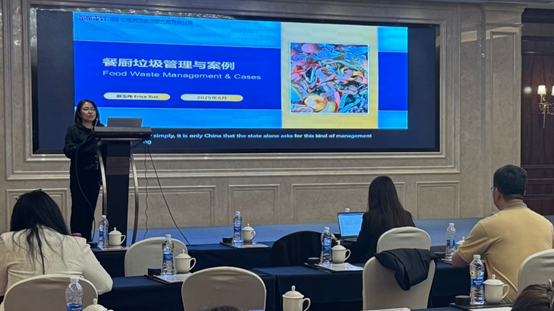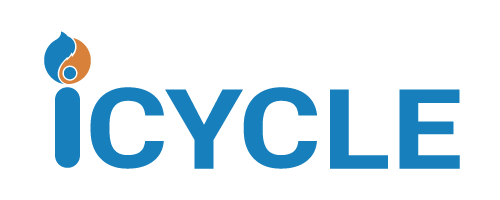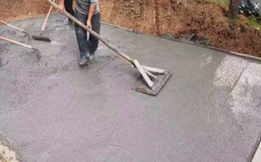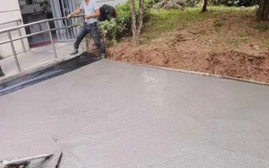From 12 to 16 May 2025, the Asian Development Bank’s seminar on “Circular Economy and Sustainable Solid Waste Management” was held in Shaoxing, Zhejiang Province. Xue Yuwei, Chief Economist of the China Urban Construction Research Institute, was invited to deliver a keynote speech titled “Food Waste Management and Case Studies,” offering a comprehensive presentation of China’s policies, technologies, and practical experiences in food waste management. This provided a “Chinese Solution” for organic waste management across Asia.
Xue Yuwei highlighted that in 2023, the annual generation of food waste in major Chinese cities exceeded 82 million tonnes, accounting for 20–37% of total municipal solid waste. Improper disposal can lead to environmental pollution and public safety risks, such as the production of “gutter oil.” Advancing the segregation, resource utilisation, and safe treatment of food waste has therefore become a critical measure for achieving China’s “Dual Carbon Neutrality” goals and building an ecologically sustainable “Beautiful China.”.
I. Policy Guidance: Transitioning from “Safe Disposal” to “Resource Recovery”
China’s food waste management policy has evolved from initial efforts to curb “gutter oil” and reliance on landfilling towards an emphasis on resource recovery. In recent years, the national “Dual Carbon” strategy has accelerated the introduction of supportive policies:
- The “14th Five-Year Plan for the Development of Municipal Solid Waste Classification and Treatment Facilities” sets a target for national daily food waste treatment capacity of 70,000 tonnes by 2025, with anaerobic digestion technology accounting for over 60%.
- The Ministry of Agriculture and Rural Affairs has banned the direct use of food waste as animal feed to prevent homologous contamination.
- The State Council’s “Opinions on Comprehensively Promoting the Construction of a Beautiful China” emphasises establishing a fully integrated, closed-loop system encompassing “segregation–collection and transport–treatment–resource utilisation.”
II. Technological Pathways: Diversified and Locally Adapted Approaches
China has established a diversified technological framework, dominated by anaerobic digestion, and supplemented by aerobic composting, biotransformation, and co-processing in waste-to-energy plants:
- Anaerobic digestion accounts for over 80% of treatment capacity, converting organic matter into biogas for electricity generation or upgrading to bio-compressed natural gas (Bio-CNG), offering high energy recovery efficiency.
- Aerobic composting is suitable for small and medium-sized towns, though it faces challenges such as low market uptake of the resulting compost.
- Biotransformation technologies (e.g., using black soldier fly or housefly larvae) are well-suited for small-scale, distributed treatment systems, producing high-protein animal feed and organic fertiliser with high added value.
- Compact, decentralised treatment systems are being rapidly deployed at county-level, reducing transportation costs and increasing operational flexibility.
III. Benchmark Cases: Integrated Technology and Synergistic Park Models
Xue Yuwei presented several major projects designed or supported by the China Urban Construction Research Institute:
- Fuzhou Food Waste Project: Processes 500 tonnes per day using advanced systems including “pneumatic conveying, thermal hydrolysis, and impurity removal.” It enables biogas power generation, co-treatment of wastewater, and incineration of residues, achieving full-chain resource recovery. The project received the “First Price in 2023 Beijing Excellent Engineering Survey and Design.”
- Beijing Gao’antun Food Waste Plant (2025): Beijing’s largest dedicated food waste treatment facility, achieving over 90% grease recovery and generating 80–100 m³ of biogas per tonne of waste. Integrated with photovoltaic panels, the plant reduces carbon emissions by approximately 38,000 tonnes of CO₂ equivalent annually, forming a multi-energy complementary system.
- Yichang Food Waste Project: Employs an advanced process chain of “wet anaerobic digestion + MBR + nanofiltration + advanced oxidation,” achieving zero liquid discharge and reducing operational costs.
- Suzhou Jingmi and Xi’an Jiemu Projects: Utilise “fly larvae engineering” and “black soldier fly” bioconversion technologies, respectively, to achieve high-value products. The Xi’an facility processes 100 tonnes per day, generating an annual revenue of ¥21.9 million, demonstrating significant economic benefits.
IV. Future Outlook: Advancing Towards High-Quality Development
Xue Yuwei outlined four key trends for the future of food waste management:
- Technological Innovation: Scaling up biochar production for carbon sequestration, raising quality standards for digestate and biogas slurry, and promoting higher-value products.
- Intelligent Management: Leveraging IoT and big data platforms (e.g. Chengdu’s GalileoOS, Terra Phoenix Group of Companies’ Internet of Waste Things) for smart, real-time monitoring of the entire waste management process.
- Policy Coordination: Improving cost-covering charging mechanisms and green finance instruments to strengthen incentives for resource-oriented projects.
- Public Participation: Enhancing public awareness campaigns to improve waste segregation at source and promote green lifestyles.

The presentation, noted for its substantive content and illustrative case studies, was highly commended by attendees. It effectively showcased China’s technical expertise and innovative approaches in organic waste resource recovery, offering valuable insights for other Asian cities pursuing green, low-carbon urban transformation.




